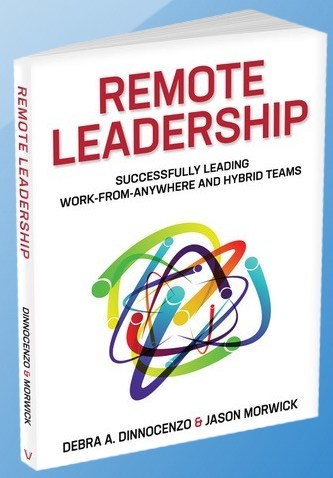PITTSBURGH, March 30, 2021 /PRNewswire/ — The dispersed workforce, hybrid teams, telework, and evolving work arrangements are here to stay in the post-pandemic ‘next normal’ – and now is the time for leaders to bolster skills for leading from a distance. The new “Remote Leadership” book provides insights on seven critical areas of competence for meeting new leadership challenges in the remote workplace.
“Working from anywhere was previously a limited aspect of the workplace with minimal impact on leaders. It is now a reality of organizational life. Smart leaders will stay ahead of this curve and ensure they are prepared to meet the leadership demands in the new world of work. As hybrid work models gain popularity and new technologies continue to evolve, leaders must also pivot to new ways of selecting, engaging with, motivating, and managing the performance of talent,” said the authors, Debra A. Dinnocenzo and Jason Morwick, two established experts on the remote workplace, distance leadership, and telework.
Dinnocenzo and Morwick offer a unique depth of experience and combined expertise unparalleled among authors of similar titles. Both are deeply experienced consultants, trainers, and business leaders, culminating in their combined forty-plus years of experience in the evolving and increasingly remote workplace. Dinnocenzo and Morwick have first-hand experience as remote leaders, and each has previously published several books on related topics, including “How to Lead From a Distance” and “Making Telework Work.” Their latest book, REMOTE LEADERSHIP: Successfully Leading Work-From-Anywhere and Hybrid Teams (2021, Walk the Talk), was released in March 2021.
Here are seven critical areas of success for leaders of remote and hybrid teams that are addressed in “Remote Leadership”:
- Building Trust in the Remote Workplace. The key aspects of building trust from a distance include familiarity, reliability, and integrity, as well as communication. Dinnocenzo suggests that, “Leaders should reach out often, remembering to use voice-to-voice, real-time connections when possible, to establish and strengthen bonds of trust in remote teams. When remote teams experience declines in trust, productivity declines follow.”
- Communicating from a Distance. As Dinnocenzo frequently reminds leaders, “This is not the time to under-communicate.” Leveraging technology tools to connect, creating ‘virtual presence’ to replicate the ‘human touch’ of leadership, is vitally important to bridging the distance with remote team members. She continues, “Remote leaders must hone the ability to ‘listen between the lines’ when talking with team members to pick up on cues that indicate motivation problems, frustration, stress, or dissatisfaction that is hindering engagement or performance.”
- Engaging for Results in Remote Meetings and Presentations. Utilizing an expanding array of tech tools for meeting remotely, Dinnocenzo reminds leaders to “replicate and simulate as much as possible in the remote environment the on-site interactions and experiences of our previous traditional workplace.” Morwick, adds, “Effective meetings and engaging presentations keep remote teams connected, on the same page, and actively participating in the necessary interactions to achieve team results.”
- Hiring and Onboarding Remotely. Morwick highlights the challenges of acquiring and integrating new team members from a distance, “Leaders need to effectively engage with candidates, convey the organizational culture, and provide compelling reasons to join the organization, while also vetting candidates through targeted interviewing processes that ensure a good match with the culture.” He adds, “Having a robust and more structured onboarding process is increasingly important as more new hires will join an expanding number of dispersed teams.”
- Coaching and Developing Remote Team Members. Ensuring that teams are best equipped to deliver on results, remote leaders must clearly establish performance expectations, deliverables, deadlines, objectives, and milestones for monitoring or reporting results. Additionally they must be available to help and coach when needed, proactively addressing deviations from standards, goals, and business plan targets. Dinnocenzo emphasizes that, “The remote workplace will go a long way toward reinforcing the importance and use of effective performance management.”
- Sustaining Culture in a Dispersed Organization. When team members have less face-to-face interaction, remote leaders must ensure that the organizational culture doesn’t become diluted. Morwick encourages leaders to “select team members with traits that align with the culture, role model desired behaviors, and continually reassess established norms to ensure culture is maintained.”
- Collaborating and Innovating in the Virtual Workplace. Building on effective trust and communication within the team, leaders can leverage remote work as a catalyst for innovation. Morwick notes that leaders should, “Get the right team together, follow a structured process, and master the tools that facilitate collaboration.”
About Walk The Talk:
Walk The Talk was founded in 1978 to help individuals and organizations achieve their highest levels of personal and professional success. For over four decades, Walk The Talk has inspired tens of thousands of leaders and team members worldwide to be the best they can be with proven resources that develop effective and respected leaders, motivate and inspire team members, and provide organizations with the necessary skills for today’s ever-changing workplace requirements and challenges. (www.walkthetalk.com)
For additional information or to schedule an interview, contact:
Debra Dinnocenzo (412-855-6777 –
306265@email4pr.com
)
SOURCE Debra A. Dinnocenzo and Jason Morwick



